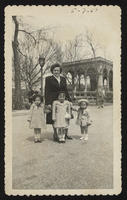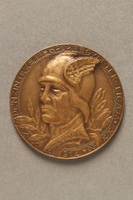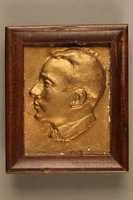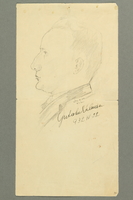Overview
- Brief Narrative
- Medal with a man holding a laurel wreath, presented to Kálmán Gutlohn in Budapest, Hungary, before he was conscripted into a forced labor unit in 1941. Kálmán worked in the Foreign Currency Department at the Budapest City Savings Bank and was an active athlete, competing in many shooting and rowing competitions. In 1939, Kálmán married American-born Anna Farkas and they lived in Pest, Budapest. In 1940, Hungary joined the Axis Alliance and passed race laws similar to Germany’s Nuremberg laws. In 1941, Kálmán and the other Jewish men in the community were conscripted for forced labor to work in multiple areas in and near Budapest. Anna used her American citizenship to get Kálmán released and he returned home on November 9, 1944. Days later, he was arrested, escaped a forced march, and found protection at an American internment camp. He later escaped the German S.S. takeover of the camp and went into hiding in his family’s apartment. During the Siege of Budapest beginning on December 25, 1944, Kálmán hid in the destroyed apartment with help from his wife. Russian forces liberated Pest on January 18, 1945 and in February, Kálmán went to Bucharest to work in the Identification Department at the American Joint Distribution Committee. Anna, her two sons, and their daughter joined him in June. Anna and the children sailed to the United States at the end of November and after his paperwork was approved, Kálmán joined them in January 1947. He changed his name to Clarence Grant and found work as a banker for a Hungarian firm in New York.
- Date
-
received:
before 1941
- Geography
-
received:
Budapest (Hungary)
- Credit Line
- United States Holocaust Memorial Museum Collection, Gift of Mary Aviyah Farkas
- Markings
- back, center, engraved : I
- Signature
- front, bottom, embossed : BM
- Contributor
-
Subject:
Kálmán C. Gutlohn Grant
- Biography
-
Kálmán Clarence Gutlohn Grant (born Kálmán Gutlohn, 1910-1986) was born in Budapest, Hungary, to Zsigmond (1870-1937) and Janka Sonneschein (1877-1961) Gutlohn. Zsigmond served as a soldier in the Austro-Hungarian army during World War I, and owned a grocery store over which the family lived in an apartment. Kálmán had two siblings, Sándor (1909-1942) and Rózsa (1914-1979). Kálmán attended a traditional Jewish elementary school followed by a Jewish gymnasium, where he graduated in 1926. Following his schooling, Kálmán attended the Academy of Commerce for training in banking practices. Afterwards, he secured a job at the Budapest City Savings Bank, where he worked as a clerk in the Foreign Currency Department for 11 years. He was also an active athlete and competed in many shooting and rowing competitions. He spoke fluent English, German, and Hungarian.
In 1939, Kálmán married American-born, Catholic, Anna Farkas (1912-1983), becoming stepfather to her sons, Gaston (b. 1932) and Rudolph (b. 1933). Anna’s parents had immigrated to the United States from Hungary around 1907, but moved back to Hungary when Anna was 9 years old. Anna had nine siblings, and at 17, she left home and moved with her older sister to Budapest, where she became an English tutor for wealthy children. In September 1938, Anna began working for the Totis family, teaching their daughter, Zsuzsanna, English. After Anna married Kálmán in 1939, her two sons lived with her parents on their farm in Bucsa. Between 1938 and 1941, Hungary passed race laws similar to Germany’s Nuremberg laws, and joined the Axis alliance in 1940. In 1941 Kálmán was conscripted for forced labor in the 109/36 Company. The company commander was Istvan Kovacs, a well-known Budapest lawyer, who tried to maintain decent living conditions for the laborers, and the guards for the company were often permissive and lenient. Their first assignment took them away from Budapest, but the company commander was able to get them assigned to the Goldberger Textile Factories in Budapest with the help of Paul Totis (Anna’s employer), the city’s Jewish Community, and the Ministry of Defence. Kálmán was sent to the Obuda section, close to the couple’s home in Pest, which allowed him to visit his family on occasion. While Kálmán worked on the labor force, his brother Sándor was serving in the transportation corps of the Hungarian Army, was sent to the Soviet front, and was killed in 1942.
Anna gave birth to their first daughter, Victoria (1944-2014), in January 1944, and later moved in with Kálmán’s mother and sister at their Pest apartment. In March, German forces occupied Hungary. In April, Hungarian authorities began ordering the Jewish population into ghettos with police-guarded perimeters. During this time, Kálmán was transferred to Diósgyőr, the Hungarian State Railway’s foundry, about 115 miles to the northeast. A regular train schedule allowed Anna to travel there in secret, sometimes bringing their daughter along. Under German occupation, the labor company’s guards were replaced and increased in numbers, and the Jewish men were assigned the toughest work. As an industrial plant, Diósgyőr came under severe bombardment by Allied planes. During the attacks, the guards were able to enter bomb shelters, but Kálmán and the other Jewish forced laborers were not allowed in and fled to nearby woods. Afterwards, they were responsible for clearing rubble and moving the bodies.
In October, a new Hungarian government took control, dominated by the fascist Arrow Cross party. In an attempt to prevent deportation, Vice-Consul Carl Lutz at the Swiss Legation began issuing diplomatic protective letters to Jews, and Anna obtained one for her husband (as an American citizen, she had already been under the protection of the Swiss consulate). She was also granted permission to move her family into a protective internment camp under the Swiss, but Anna chose to remain at home awaiting Kálmán’s release. He returned home from forced labor on November 9, 1944 and two days later, the Arrow Cross and police arrested him and other Jewish residents and then collected them at the brickworks in Obuda. They were supposed to be sent on a forced march, but Kálmán and four other men were able to bribe a soldier to help them escape. He made his way to the "protective internment camp" maintained by American Jewish Joint Distribution Committee, located in the Institute for Deaf Mutes on Festetich Street. However, he was unable to contact Anna at their home. Unaware that he had escaped, she followed the march over 20 miles before returning home to find a message from Kálmán. On November 18, a Jewish ghetto was established in Budapest and Kálmán’s mother, Janka, was forced to move there. Anna had given Kálmán’s sister, Roszi, her baptism certificate from the U.S., allowing Roszi to avoid the ghetto by posing as a Christian seamstress.
On December 13, German S.S. surrounded the Festetich Street building, searched for Jews, and took them to the Danube River to be killed. Kálmán managed to escape and return home, where he successfully hid. On Christmas day, the Soviet army besieged the city and airplanes began bombing the houses around them, knocking out the windows in the couple’s apartment. They took shelter in the bathroom with the baby until January, when Anna and her daughter moved to the basement with the other building residents while Kálmán remained upstairs in hiding. They managed to survive a direct hit to the building, but Kálmán continued to hide alone without heat or running water, only able to eat what Anna managed to sneak up to him. He remained in hiding until Russian forces liberated Pest on January 18, 1945, though Buda was still under siege. Many in Pest died of starvation, but Anna’s American status enabled her to get daily rations for her family from the Unitarian Church on Kohary Street, which had set up a kitchen for American and British citizens. Kálmán retrieved his mother, Janka, from the Budapest ghetto, and brought her to live with him, his sister, his wife, and daughter.
In February 1945, Kálmán left abruptly for Bucharest, Romania, and found work in the Identification Department at the American Jewish Joint Distribution Committee. Anna left Budapest and brought her daughter to join her two sons at her parent’s farm in Busca, and in June, they left to join Kálmán in Bucharest. As Americans, Anna and the children were able to sail to the United States at the end of November, settling in New York. Kálmán had to wait for his paperwork to be approved but was able to leave Bucharest in January 1947 and sailed to Paris. There he continued to work for the Joint until he was finally able to sail to the US in August 1947, his trip sponsored by American cousins, Clarence and Leo Sonnenschein. He reunited with his family and met his new daughter Alexandra (1946-2005), who was born in the US while he was awaiting passage. They later had a third daughter, Mary (b. 1948). Kálmán became manager of Deak & Company’s foreign exchange office. Anna and Kálmán separated, and he moved to Miami in 1958.
Physical Details
- Classification
-
Awards
- Category
-
Medals
- Object Type
-
Medals, Hungarian (lcsh)
- Genre/Form
- Medals.
- Physical Description
- Circular, tarnished, brass-colored metal medallion. On the front, in relief, is a man standing in profile with his right arm outstretched, holding a wreath of laurel leaves. He is bare from the waist up with fabric draped around the lower half of his body and tossed over his right shoulder. His left hand is by his side, holding a scroll. Behind him is an engraved low brick wall with foliage and mountains in the background. On the back are two laurel branches with looped stems that curve upwards to form a wreath shape. The ends of the branches are crossed at the bottom and tied with a ribbon. Engraved inside the wreath is a singular Roman numeral. A suspension loop and suspension ring protrude from the top of the medal.
- Dimensions
- overall: | Diameter: 1.375 inches (3.493 cm)
- Materials
- overall : metal
Rights & Restrictions
- Conditions on Access
- No restrictions on access
- Conditions on Use
- No restrictions on use
Keywords & Subjects
- Topical Term
- Jews--Persecutions--Hungary--Budapest. Outdoor recreation--Hungary. Sports--Hungary--Budapest--20th century. World War, 1939-1945--Conscript labor--Hungary. Medals--Hungary. Escaped prisoners. Bombing, Aerial--Hungary. Detention of persons--Hungary. Holocaust survivors--Family relationships. Race discrimination--Law and legislation--Hungary.
- Geographic Name
- Budapest (Hungary) Bucharest (Romania)
Administrative Notes
- Legal Status
- Permanent Collection
- Provenance
- The medal was donated to the United States Holocaust Memorial Museum in 2018 by Mary Aviyah Farkas, the daughter of Kálmán Clarence and Anna Farkas Gutlohn Grant.
- Record last modified:
- 2023-08-29 13:06:27
- This page:
- https://collections.ushmm.org/search/catalog/irn619026
Download & Licensing
In-Person Research
- By Appointment
- Request 21 Days in Advance of Visit
- Plan a Research Visit
- Request to See This Object
Contact Us
Also in The Kálmán Clarence and Anna Farkas Gutlohn Grant collection
The collection consists of medals, a plaque, a sketch, documents, and photographs relating to the varied experiences of Kálmán Clarence and Anna Farkas Gutlohn Grant in Hungary before, during, and after the Holocaust.
Date: after 1887-before 2017

Kalman Clarence and Anna Farkas Gutlohn Grant family papers
Document
Identification papers, personal narratives, genealogy, correspondence, and photographs documenting the family history of the Gutlohn, Farkas, and Sonnenschein families of Hungary, including Kálmán Clarence Gutlohn Grant’s forced-labor experiences during World War II, and his and his wife Anna Farkas Gutlohn Grant’s immigration to the United States. Biographical material consists of family history and genealogy related to the Gutlohn, Farkas, and Sonnenschein families, Anna’s baptism certificate, Anna and Kálmán’s marriage certificate, and the passenger list from the SS Warren Delano. Kálmán’s documents include identification cards, a leave pass for his forced-labor battalion, financial documents, a clipping about his rowing team, and French documents related to his emigration from Europe in 1947. Also included are three bound journals of Anna’s begun in 1946 and chronicle her wartime experiences in Hungary. Kálmán’s correspondece includes a 10 page letter from Anna written while she was aboard the SS Warren Delano on her way to the United States in 1945 and postwar letters from Kálmán to friends and family in which he discusses his forced-labor experiences. Publications consist of a Hungarian-Latin dictionary used and inscribed by Kálmán and his brother Sandor, a Felix Potin sponsored Paris metro map, and a map of the Buda Hills used by Kálmán. Also included is a copy of a drawing depicting a British, Italian, and Russian soldier squeezing the neck of a Nazi vulture. The drawing is credited to Kennedy and was displayed in the Kalman home in the United States. Photographs consist of prewar depictions of Anna and Kálmán and their extended families, including the Gutlohns, Farkas, and Sonnenscheins, wartime photographs of Kálmán with his forced-labor battalion, and postwar family photographs in Bucharest and the United States.

Shooting medal presented to a Hungarian Jewish man by the Budapest Metropolitan Municipal Financial Institution Sports Association
Object
Medal with a beehive design (by Erdey Dezsö, a Hungarian sculptor) presented to Kálmán Gutlohn by the Budapest City Savings Bank Sports Association, for a shooting competition in 1935. Kálmán worked in the Foreign Currency Department of the Bank and was an active athlete, competing in many shooting and rowing competitions. In 1939, Kálmán married American-born Anna Farkas and they lived in Pest, Budapest. In 1940, Hungary joined the Axis Alliance and passed race laws similar to Germany’s Nuremberg laws. In 1941, Kálmán and the other Jewish men in the community were conscripted for forced labor to work in multiple areas in and near Budapest. Anna used her American citizenship to get Kálmán released and he returned home on November 9, 1944. Days later, he was arrested, escaped a forced march, and found protection at an American internment camp. He later escaped the German S.S. takeover of the camp and went into hiding in his family’s apartment. During the Siege of Budapest beginning on December 25, 1944, Kálmán hid in the destroyed apartment with help from his wife. Russian forces liberated Pest on January 18, 1945 and in February, Kálmán went to Bucharest to work in the Identification Department at the American Joint Distribution Committee. Anna, her two sons, and their daughter joined him in June. Anna and the children sailed to the United States at the end of November and after his paperwork was approved, Kálmán joined them in January 1947. He changed his name to Clarence Grant and found work as a banker for a Hungarian firm in New York.

Medallion from the Financial Institutions Sports Union League awarded to a Hungarian Jewish athlete
Object
Medal with a man wearing a winged helmet, presented to Kálmán Gutlohn by the Financial Institutions Sports Union League in Budapest, Hungary, for an athletic competition in 1936. Kálmán worked in the Foreign Currency Department of the Bank and was an active athlete, competing in many shooting and rowing competitions. In 1939, Kálmán married American-born Anna Farkas and they lived in Pest, Budapest. In 1940, Hungary joined the Axis Alliance and passed race laws similar to Germany’s Nuremberg laws. In 1941, Kálmán and other Jewish men in the community were conscripted for forced labor to work in multiple areas in and near Budapest. Anna used her American citizenship to get Kálmán released and he returned home on November 9, 1944. Days later, he was arrested, escaped a forced march, and found protection at an American internment camp. He later escaped the German S.S. takeover of the camp and went into hiding in his family’s apartment. During the Siege of Budapest beginning on December 25, 1944, Kálmán hid in the destroyed apartment with help from his wife. Russian forces liberated Pest on January 18, 1945 and in February, Kálmán went to Bucharest to work in the Identification Department at the American Joint Distribution Committee. Anna, her two sons, and their daughter joined him in June. Anna and the children sailed to the United States at the end of November and after his paperwork was approved, Kálmán joined them in January 1947. He changed his name to Clarence Grant and found work as a banker for a Hungarian firm in New York.

Framed, gold-colored plaque depicting a Jewish Hungarian banker
Object
Gold-painted plaster relief of Kálmán Gutlohn of Budapest, Hungary, based on a pencil-sketch drawn on April 22, 1932 (2018.286.5). Kálmán worked in the Foreign Currency Department of the Bank. In 1939, he married American-born Anna Farkas and they lived in Pest, Budapest. In 1940, Hungary joined the Axis Alliance and passed race laws similar to Germany’s Nuremberg laws. In 1941, Kálmán and other Jewish men in the community were conscripted for forced labor to work in multiple areas in and near Budapest. Anna used her American citizenship to get Kálmán released and he returned home on November 9, 1944. Days later, he was arrested, escaped a forced march, and found protection at an American internment camp. He later escaped the German S.S. takeover of the camp and went into hiding in his family’s apartment. During the Siege of Budapest beginning on December 25, 1944, Kálmán hid in the destroyed apartment with help from his wife. Russian forces liberated Pest on January 18, 1945 and in February, Kálmán went to Bucharest to work in the Identification Department at the American Joint Distribution Committee. Anna, her two sons, and their daughter joined him in June. Anna and the children sailed to the United States at the end of November and after his paperwork was approved, Kálmán joined them in January 1947. He changed his name to Clarence Grant and found work as a banker for a Hungarian firm in New York.

Pencil sketch of a Jewish Hungarian banker
Object
Pencil sketch of Kálmán Gutlohn of Budapest, Hungary, created on April 22, 1932, and possibly used as a study for the plaster relief (2018.286.5). Kálmán worked in the Foreign Currency Department of the. In 1939, he married American-born Anna Farkas and they lived in Pest, Budapest. In 1940, Hungary joined the Axis Alliance and passed race laws similar to Germany’s Nuremberg laws. In 1941, Kálmán and other Jewish men in the community were conscripted for forced labor to work in multiple areas in and near Budapest. Anna used her American citizenship to get Kálmán released and he returned home on November 9, 1944. Days later, he was arrested, escaped a forced march, and found protection at an American internment camp. He later escaped the German S.S. takeover of the camp and went into hiding in his family’s apartment. During the Siege of Budapest beginning on December 25, 1944, Kálmán hid in the destroyed apartment with help from his wife. Russian forces liberated Pest on January 18, 1945 and in February, Kálmán went to Bucharest to work in the Identification Department at the American Joint Distribution Committee. Anna, her two sons, and their daughter joined him in June. Anna and the children sailed to the United States at the end of November and after his paperwork was approved, Kálmán joined them in January 1947. He changed his name to Clarence Grant and found work as a banker for a Hungarian firm in New York.



